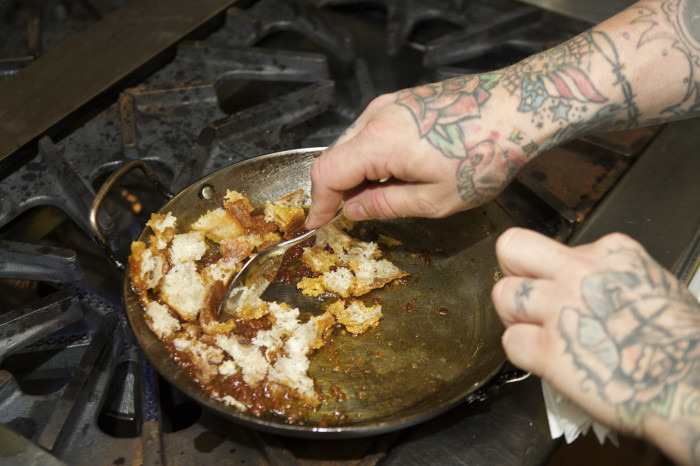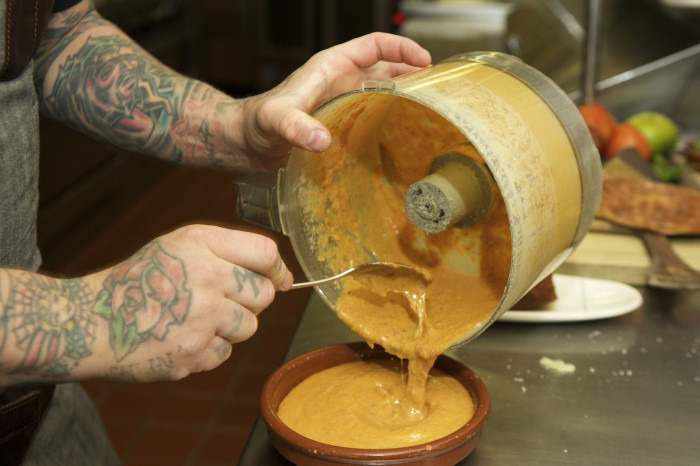Jamie Bissonnette Puts The "Do" In 'Nduja
We may receive a commission on purchases made from links.
James Beard Award–winning Toro and Coppa chef Jamie Bissonnette knows his way around the vast world of preserved meat and fish. He's a master of charcuterie (coppa is Italian cured pork neck) and an avid collector of canned Spanish seafood — an enviable hobby if you've ever loved a smoked mussel or glistening sardine in your life. Equally praise-worthy: his faculty and creativity with 'nduja, a spicy, spreadable, melt-in-your-mouth fermented sausage. With roots in Italy, cousins around the globe and appearances on menus from French and Spanish to New American and even comfort food, this is one trendy ingredient that goes wherever spicy pork goes.
'Nduja's ingredients are simple and humble, but its ratios are bold: It's 60 to 80 percent pork fat, with the remainder composed of lean ground pork and a heavy-handed dose of fiery red pepper flakes and other spices. The blend ferments for one to three days, depending on how much tangy salami flavor you're going for, and can be smoked after fermenting if desired.
Easier to find than ever before and more versatile than you thought possible, 'nduja (pronounced...well, you'll see) is a mainstay of Bissonnette's home and restaurant larders alike.
Three important questions: How do you pronounce 'nduja, how does everyone else pronounce it and how is it supposed to be pronounced?
I don't know how it's supposed to be pronounced, but I've always called it "DU-jah," which is how I heard someone pronounce it the first time. It's like if you grow up in a certain part of the world, you say "to-mah-to" and that's just how it is for the rest of your life. So for me it's "DU-jah," but I read an article recently that had it pronounced phonetically as "NU-zha" with a silent "d."
That's one I haven't heard. I've heard "DU-yah" most often.
I've heard "DU-yah" as well and sometimes intentionally try to call it "DU-yah," then I slip back and call it "DU-jah." It's like, sometimes I say "I'm going to the bah in the cah," even though I really try to say "bar in the car." But oftentimes it just doesn't work out in my favor.
What is it about 'nduja that's landing it on all kinds of menus in a huge range of applications?
I have no idea why 'nduja is a trend, but I love that it is. I've always loved it, and it's been kind of difficult to find up until now. As it's gotten more popular, I've gotten more excited about it. It's delicious — it's got all the things that I love: that sour, fermented flavor of salami, the fattiness. I love pork rillettes and I love sobrassada, which is a similar sausage made in Mallorca, Spain. I love all of those things so much, and 'nduja just embodies it. It's tangy, fatty, gamey, spreadable. I wanted to do a grilled cheese with it, but I felt like that's just too typical, so I decided to render it, strain it and use the fat for migas, or as I call it, "Wonder Bread." At home, I warm up Campbell's tomato soup and I take a hand blender and blend 'nduja into it.

How much fat are you getting out of it when you render it?
Not much, so I add olive oil. It's more flavoring the olive oil than rendering the fat.
What was your first experience with 'nduja?
The first time I had it was in France. On my day off, I went to a shop, got some wine, cheese, a baguette and stuff to sit and eat outside. I saw 'nduja, figured out what it was, bought it and that was that.

Where does it originate? Whose culture does it originate from?
I believe that 'njuda is from Italy, but I don't know. There's such a mash of culture from wars and whatnot, conquering different parts of the world. I thought I knew about pizza until I read that pizza was actually supposed to mimic pita. So, who knows? Like I say, the more you know, the less you know.
Versatility-wise, you really can't do better. You can spread it on a sandwich, you can fry things with it or even just pinch bits off and smudge them on a plate as an accent.
Absolutely, and I love hearing people's surprise when they try it for the first time.
If the home cook wants to try their hand at some 'nduja magic, where are they most likely to find it?
La Quercia out of Iowa makes a domestic 'nduja. You can buy it online. You can even get it on Amazon. Some kinds of it are just more sour and spicy and kind of hit you in the face, so try a few to see how you like yours.

